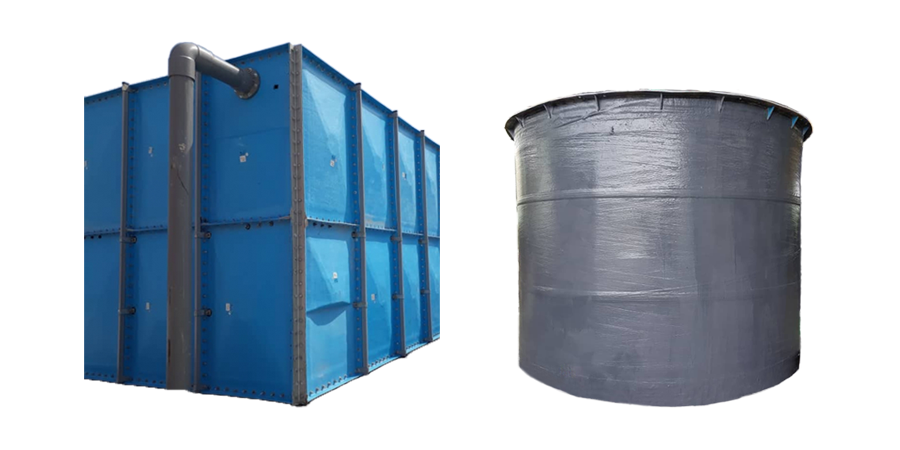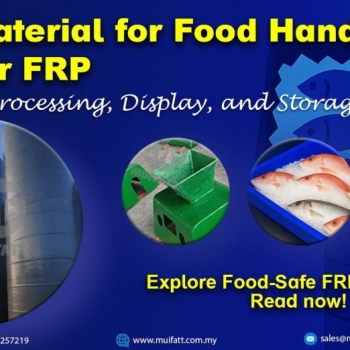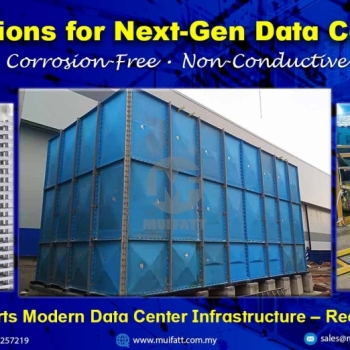FRP pultruded profiles are reshaping structural possibilities across Malaysia. From STP staircases to public park shelters, explore how these modular components enable custom FRP solutions—only from Mui Fatt.
Cooling Towers: Components, Working Principles, and Construction | Complete Guide
16 Jun 2023
The Different Types of Chiller Plant and Its Common Usage
There are two common types of chiller plants: Water-Cooled and Air-Cooled, they work similarly throughout most of the process.

As water conducts heat better than air, water-cooled chillers are known for being more consistent and efficient in their performance and having a longer lifespan than their air-cooled counterparts. Water-cooled chillers are common in medium and larger facilities, such as airports, hospitals, hotels, shopping malls, commercial buildings, and more.
On the other hand, air-cooled chillers are more prevalent in small to medium sized facilities where space and water may be limited. The costs to install and maintain these chillers are lower than that of their water-cooled counterparts, but they typically have a shorter lifespan. These chillers are commonly used for restaurants, corporate and sporting events, and temporary structures.
In this article, we will be discussing on the primary components of Water-Cooled Chiller Plants, how it works, and from what material it is built from.
Primary Components of Water-Cooled Chiller Plant
A water-cooled chiller plant typically consists of three primary components:
Chiller
The chiller is responsible for removing heat from the process or building being cooled. It circulates chilled water through a refrigeration cycle, absorbing heat from the process and rejecting it to the condenser water loop.
Condenser Water System
The condenser water system serves as a heat rejection medium for the chiller. It typically consists of a condenser, condenser water pump, and associated piping. The hot refrigerant gas from the chiller is condensed in the condenser, transferring heat to the water circulating in the condenser water loop.
Cooling Tower
The cooling tower is a heat rejection device that dissipates heat from the condenser water loop. It provides a large surface area for the transfer of heat from the hot condenser water to the surrounding air through evaporation and convection. The cooled water is then returned to the condenser for the chiller’s heat rejection process.
Out of these three components, the cooling tower is an essential component of a water-cooled chiller plant. It plays a critical role in maintaining the proper temperature of the condenser water loop and ensuring the efficient operation of the chiller plant. The cooling tower uses the principles of evaporation and airflow to remove heat from the water, allowing it to be recycled back to the condenser for continuous cooling.
The Comprehensive Working Principles of a Cooling Tower
The cooling tower system operates based on the following working principles:
Hot Water Circulation
The cooling tower system starts with the circulation of hot water, which is typically a byproduct of an industrial process or the condenser water from a chiller system. It enters the cooling tower through the inlet pipe.
Water Distribution
Inside the cooling tower, the hot water is evenly distributed over the fill media, which consists of a packing material with a large surface area, such as PVC. This promotes contact between the water and air.
Heat Transfer
As the hot water flows over the fill media, it comes into contact with ambient air. Heat from the hot water is transferred to the air through convection and evaporation. Some of the water evaporates, carrying away the heat energy and cooling the remaining water.
Airflow
The cooling tower has fans or natural draft mechanisms that create airflow. The airflow can be induced draft (fans pull air through the tower) or forced draft (fans push air into the tower). It aids in the evaporation process and removes heat from the tower.
Evaporation
As the hot water flows over the fill media and encounters the airflow, a portion of the water evaporates, taking away the heat energy. Evaporation provides the primary mechanism for cooling the water. The process releases latent heat and results in a drop in water temperature.
Drift Elimination
During the evaporation process, small water droplets can be carried away with the exhaust air. Drift eliminators are installed in the cooling tower to capture and minimize the amount of water lost through drift. This helps conserve water and prevent environmental concerns.
Cooled Water Collection
The cooled water, after passing through the fill media and the evaporation process, collects at the bottom of the cooling tower in a sump or basin.
Recirculation
The cooled water in the sump or basin is then recirculated back to the process or chiller condenser to absorb more heat and repeat the cooling cycle. The recirculation process continues as long as there is a demand for cooling.
Make-Up Water
Due to evaporation and drift losses, water levels in the cooling tower decrease over time. Make-Up water is added to compensate for these losses and maintain the desired water level. The make-up water can be supplied from a dedicated make-up tank or a connected water source.
A cooling tower effectively dissipates heat and provides cooled water for industrial processes or chiller systems by continuously circulating hot water, promoting heat transfer through evaporation, and utilizing airflow. The working principle allows for the efficient cooling of water, contributing to temperature control and energy efficiency in various application.

Anatomy of a Cooling Tower with a Make-up Tank and Its Construction
You may have been wondering, or perhaps you already know, Fiberglass-Reinforced Plastic (FRP) can be used to construct almost the entire cooling tower! Thanks to its unique features such as corrosion/chemical resistant, weather resistant, high strength-to-weight ratio, durability, versatility, low conductivity to algae growth, and ease of maintenance.
Cooling Tower Structure
 The cooling tower is typically a large tower-like structure that houses various components. It is designed to facilitate the cooling of water through the process of evaporation and heat transfer. The outer shell of the cooling tower, known as casing, provides structural support and protection. These casings are typically made of FRP panels or molded/assembled roofing sheets that form the tower’s shape.
The cooling tower is typically a large tower-like structure that houses various components. It is designed to facilitate the cooling of water through the process of evaporation and heat transfer. The outer shell of the cooling tower, known as casing, provides structural support and protection. These casings are typically made of FRP panels or molded/assembled roofing sheets that form the tower’s shape.
Water Distribution System
 The water distribution system evenly distributes water over the fill media. It consists of pipes, spray nozzles, or distribution basins that ensure proper water flow and coverage. The pipes and fittings in the water distribution system are typically made of FRP pultruded profiles, such as round tubes, to ensure efficient contact between the water and the air for effective heat transfer.
The water distribution system evenly distributes water over the fill media. It consists of pipes, spray nozzles, or distribution basins that ensure proper water flow and coverage. The pipes and fittings in the water distribution system are typically made of FRP pultruded profiles, such as round tubes, to ensure efficient contact between the water and the air for effective heat transfer.
Fill Media Support Structure
Inside the cooling tower, there is a fill media support structure, which holds the fill media in place and allows for proper water distribution. It is usually constructed using FRP pultruded profiles, such as beams, grids, or channels.
Fill Media
The fill media is a packing material with a large surface area that facilitates the exchange of heat between the water and the air. It enhances the contact between the water droplets and the air, promoting evaporation and heat dissipation. The fill media, also known as fill or packing, is a crucial component in a cooling tower. It provides a large surface area for water and air contact, facilitating efficient heat transfer. The fill media can be made of various materials such as PVC, polypropylene, or other plastic materials. It is typically assembled in layers or blocks within the cooling tower.
Inlet Louvers
 Located near the bottom of the cooling tower, the inlet louvers direct the incoming air towards the water distribution system. They help achieve proper airflow and water distribution throughout the tower. They can be made of FRP Louver Panels (specially designed FRP panels that form the louvers)
Located near the bottom of the cooling tower, the inlet louvers direct the incoming air towards the water distribution system. They help achieve proper airflow and water distribution throughout the tower. They can be made of FRP Louver Panels (specially designed FRP panels that form the louvers)
Fans and Drives
 Cooling towers have one or more fans that create airflow and aid in the cooling process. The fans can be mounted at the top of the tower or in a fan stack. The fan creates an upward airflow, drawing ambient air into the tower and aiding in the evaporation process. The fan blades, fan stack, and fan deck are typically made of FRP. The fan drives, such as motors and gearboxes, are usually located outside the tower in a weatherproof enclosure.
Cooling towers have one or more fans that create airflow and aid in the cooling process. The fans can be mounted at the top of the tower or in a fan stack. The fan creates an upward airflow, drawing ambient air into the tower and aiding in the evaporation process. The fan blades, fan stack, and fan deck are typically made of FRP. The fan drives, such as motors and gearboxes, are usually located outside the tower in a weatherproof enclosure.
Drift Eliminators
Drift eliminators are designed to capture and reduce the amount of water droplets carried out of the cooling tower with the exhaust air. They are usually made of FRP or PVC and are designed to capture and redirect water droplets back into the tower, reducing water losses and environmental concerns.
Drains and Sump

The cooling tower system may have drains and a sump at the bottom to remove excess water, bleed-off, or facilitate maintenance. The drains and sump are typically designed to handle water flow and constructed using FRP.
Make-Up Tank
 The make-up tank is a separate component that stores additional water to compensate for evaporation, drift (water droplets carried away with the exhaust air), bleed-off (purposely removing a portion of the water to prevent the build-up of impurities), or other losses from the cooling tower system. It ensures that the cooling tower always has an adequate water supply, thus maintaining the system’s operational efficiency and prevent potential operational issues. The make-up tank is usually equipped with valves, level sensors, and a supply line to introduce water into the cooling tower system as needed.
The make-up tank is a separate component that stores additional water to compensate for evaporation, drift (water droplets carried away with the exhaust air), bleed-off (purposely removing a portion of the water to prevent the build-up of impurities), or other losses from the cooling tower system. It ensures that the cooling tower always has an adequate water supply, thus maintaining the system’s operational efficiency and prevent potential operational issues. The make-up tank is usually equipped with valves, level sensors, and a supply line to introduce water into the cooling tower system as needed.
The Valuable Insights for Cooling Tower that consist of a Make-Up Tank
Cooling towers require a make-up tank for several reasons
Water Supply
The make-up tank serves as a reservoir of water that is continuously supplied to the cooling tower. The tower relies on a constant flow of water to facilitate the cooling process. It ensures an adequate supply of water, especially during peak cooling periods or when the water demand exceeds the supply capacity.
Water Level Control
The make-up tank helps maintain a consistent water level in the cooling tower. The water level needs to be carefully regulated to ensure optimal cooling performance. The tank acts as a buffer, providing a stable water source even when there are fluctuations in the water supply or demand.
System Shutdown
During maintenance or unexpected shutdowns, the water tank allows the cooling tower to continue operating for a limited period. It provides a reserve of water that can sustain the cooling process until the tower is back in operation or alternative arrangements are made.
Emergency Situations
In case of emergencies, such as power outages or equipment failures, the make-up tank can serve as a temporary source of water for the cooling tower. This helps prevent overheating of the equipment and potential damage.
Water Treatment
The make-up tank can accommodate water treatment processes, such as chemical dosing or filtration, before the water is supplied to the cooling tower. This ensures that the water is properly treated and meets the required quality standards for efficient cooling and to prevent scaling, corrosion, or biological growth in the tower.
A make-up tank is not an essential component for every cooling tower system, but it is a common and important component in many cooling tower installations. Many had chosen FRP and Polyethylene (PE) as material option for make-up tank compared to steel, considering the mild chemical existence in cooling tower.
Cooling Tower Lifespan
The lifespan of a cooling tower can vary depending on several factors, including the quality of materials, design, construction, maintenance practices, and operating conditions. However, FRP cooling towers are generally known for their durability and long service life compared to other types of cooling towers.
With proper installation, regular maintenance, and appropriate operational practices, an FRP cooling tower can have a lifespan of 20 to 30 years or more. Some well-maintained FRP cooling towers have been known to last even longer.
Here is an article from the Cooling Tower Institute located in Houston, Texas, in the Southern United States, discussing why to use Fiberglass Pultruded Structural Products in Cooling Towers - https://www.cti.org/blogs/posts/fiberglass-pultruded-structural-products-for-use-in-cooling-towers. As an experienced FRP manufacturer with over 30 years of experience, we are proud and confident to state that we not only fulfil all the materials mentioned in this article but also go beyond the expectations.
Talk to us for your project today! WhatsApp or email – sales@muifatt.com.my
We guarantee our expertise to you.
Visit our product page for more product details – FRP Pultruded Profile, FRP Sheets and Panels, FRP Roofing Sheets, FRP and PE Tanks, and FRP Sectional Panel Water Tank
References:
- The Basics of Chillers – HVAC Investigators (https://www.hvacinvestigators.com/webinars/the-basics-of-chillers-how-they-work-where-theyre-used-and-common-problems/)
Disclaimer:-
The information provided on this website is for general informational purposes only and does not constitute legal advice. While we strive to ensure the accuracy and reliability of the information provided, we make no representations or warranties of any kind, express or implied, about the completeness, accuracy, reliability, suitability, or availability concerning the information contained herein. Any reliance you place on such information is therefore strictly at your own risk. This website may contain links to other third-party websites. Such links are only for the convenience of the reader, user, or browser; which we do not warrant, recommend, endorse, or assume liability for the contents of the third-party sites.
Keep in touch with us should you be keen on receiving timely updates from us
- Website - https://www.muifatt.com.my/home/
- Facebook - https://www.facebook.com/muifattmarketing
- Instagram - https://www.instagram.com/muifattmarketing/
- Google - https://goo.gl/maps/WxVY13gNcaRTS7Jp6
- Youtube - http://www.youtube.com/@MuiFattMarketing
- TikTok - https://www.tiktok.com/@muifattmarketing
- LinkedIn - https://www.linkedin.com/company/mui-fatt-marketing-sdn-bhd-
- Linktree - https://linktr.ee/muifattmarketing
- Shopee - https://www.shopee.com.my/muifattmarketing
- Lazada - https://www.lazada.com.my/shop/mui-fatt-marketing
Recent Blog
Mui Fatt Engineering Insights - FRP Panel Tank Installation
Get to know the step-by-step assembly process of FRP sectional panel tanks, based on Mui Fatt’s industry-proven practices. This easy-to-digest guide is ideal for project managers, contractors, and technical personnel involved in water storage tank installation across Malaysia.
FRP Panels vs Traditional Alternatives: The Ultimate Guide to Durability and Sustainability
Explore why FRP (Fiberglass-Reinforced Plastic) panels outperform traditional materials like steel, plywood, and PVC in durability, sustainability, and cost-effectiveness. Discover real-world applications in MyKiosk projects and cold truck panel assembly, where FRP’s superior insulation, corrosion resistance, and lightweight properties deliver long-term benefits.
Comparing FRP Waterproofing with Traditional Systems
Is FRP lamination a better waterproofing method than traditional systems? Explore this complete guide with real project examples and see why FRP is gaining traction across Malaysia.
Benefits of FRP in Food Handling & Processing
With hygiene, durability, and corrosion resistance at its core, FRP (Fibreglass Reinforced Plastic) is becoming a preferred material in the food industry. This article explores why FRP is ideal for food handling equipment such as supermarket fish trays, water tanks, and food factory platforms, plus how Mui Fatt is delivering proven solutions through its successful FRP applications.
Mui Fatt Insights: Advanced Materials for Modern Needs
Is stainless steel the best for wet areas? This article explains why more industries are switching to FRP for its corrosion resistance, hygiene benefits, and longevity, especially in food displays and chemical exposure zones.
How FRP Supports Modern Data Center Infrastructure
Discover how fiberglass-reinforced plastic (FRP) is reshaping data center construction. Learn its key advantages, comparisons with other materials, and where to apply FRP—from rooftop chillers to cooling tanks.
Understanding FRP Filament Winding: Process, Benefits & Comparison
This article explores the FRP filament winding manufacturing method, how it differs from other FRP techniques, why it’s still widely used, and its long-term value for projects like high-strength tanks and cylinders.













